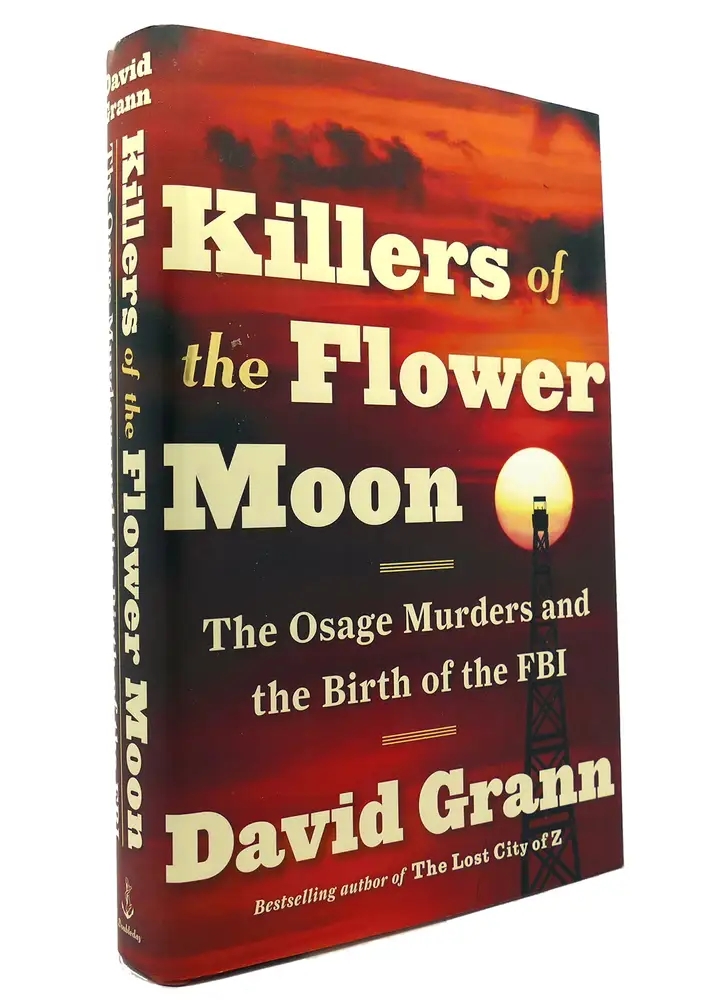by Gary Romeo
David Grann’s book, Killers of the Flower Moon, already a bestseller, is soon to be discussed even more. Martin Scorsese’s film version will be coming to your local theater in October.

Since the events take place in the 1920s, Robert E. Howard fans will most likely want to know if REH commented on “The Osage Murders.” The only comment I was able to find was a mention of the Osage Indians in a March 1932 letter to Wilfred Branch Talman.



As this copy of the actual letter is hard to read, I’m also including a more readable scan of the middle section (where REH mentions the Osage) from the latest edition of The Collected Letters of Robert E. Howard Volume 2, REH Foundation Press, 2022 for better readability. Notice the last line in the middle section “I’d much rather be an Indian than a Mexican.” is missing in both the first and second edition of the REH Foundation’s Collected Letters editions. Save your money for a third edition!

Anyway, onward… David Grann wrote a fast-paced interesting book. The title comes from an occurrence in nature that the Osage Indians noticed. In April, millions of tiny flowers spread over the hills and prairies. In May, the Moon shines larger, and certain plants like spiderworts and black-eyed Susans grow taller and creep over the tiny flowers and deprive them of light and water. The tiny flowers die. The month of May, for the Osage Indians, became the time of the flower-killing moon.

Killers of the Flower Moon is mostly about greed (and racism) and the popularization of the now endangered FBI. The Cointelpro program of the 60s/70s raised little ruckus… but… hey, don’t mess with The Donald!
The book is organized in three sections. Initially we learn that the Osage Indians, like numerous other Native American tribes, were pushed west by white settlers, until finally settling in an area considered worthless. It had poor soil and was not good farming land. The Indians originally hoped to be left alone but soon oil was discovered. The Osage were able to sell the oil and became quite wealthy. Per capita they were the richest people in the world.
With great wealth comes great envy and great greed.
“Chronicle One” introduces the reader to Molly Burkhart and her family. Mollie’s sister Anna Brown is missing. News travels fast and worry begins as another Osage, Charles Whitehorn, has vanished also. Eventually both their corpses were found. Both victims were shot in the head, execution style. Grann proceeds to tell of other victims who were shot, poisoned, and involved in car accidents; and investigations by the authorities and private agencies that lead nowhere. Several people, including whites, who investigated the deaths or sought help from the federal government also turned up dead.
“Chronicle Two” focuses on the investigation of the murders by the Bureau of Investigation (their name before becoming the FBI). Tom White, a lawman from Texas, leads the investigation. I’m not going to giveaway spoilers and ruin your enjoyment of the book or the movie. Suffice to say, he solves the murder of Anna Brown and justice prevails in this one instance. When the film The FBI Story (1959) with Jimmy Stewart hit the movie theaters, solving the Osage Murders was mentioned as an FBI triumph.
In “Chronicle Three” Grann writes about the descendants of some of the victims. He states that the Osage Reign of Terror lasted for a longer period of time than the official record shows. The Bureau’s investigation had focused on a single person and that case was solved. But other suspicious deaths were never even investigated. Grann makes an effective case that the reign of terror was more widespread than previously thought.
All in all, it was a very good book. I would have liked a better explanation on how “headrights” (the right to receive a quarterly distribution of funds derived from the Osage Mineral Estate) were exploited so easily by allowing white guardianship. I mean, what was the rationale of allowing non-Indian guardianship in the first place and why didn’t the Osage Nation challenge that more? All this was mentioned (and possibly explained) but I still feel something was missing. In any event, REH fans should appreciate this look at life in Oklahoma (just a little north of REH’s Texas) in the 1920s. Per the above letter, REH was aware of their wealth and most likely read about the reign of terror in the newspapers of his time.



Fascinating article. Looking forward to the movie.
Thanks, the book is worth the read. Martin Scorsese pretty much always makes good movies. I’m looking forward to it as well.
Pingback: Sensor Sweep: Valiant Comics, Killers of the Flower Moon, Polyhedron, Monster Hunter Bloodlines – castaliahouse.com